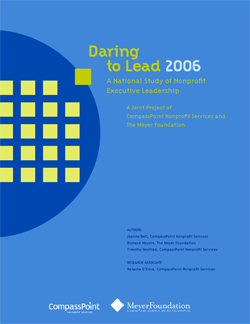Public Agency
Public Agency
2005, 98 pages. National Alliance for Media Arts and Culture, 145 Ninth Street, Suite 250, San Francisco, CA 94103, 415-431-1391
In celebration of its twenty-fifth anniversary, NAMAC invited seven authors with an intimate knowledge of their subject matter to write about overlooked or neglected media arts histories from around the country. Highlights include "Visions and Hindsights: Seattle's and/or Alternative Art Space 1974-1984" by Robin Oppenheimer and a conversation with activist archivists Andrew Lampert and Rick Prelinger by Melinda Stone.
Read More...Steve Gunderson is the new president and CEO of the Council on Foundations. After serving three terms in the Wisconsin State Legislature, Gunderson served sixteen years in the U.S. Congress, where he focused on agriculture, education, employment policy, health care, and human rights. After not seeking re-election in 1996, he served as senior consultant and managing director for the Washington office of the Greystone Group, a Michigan-based strategic management and communications consulting firm.
Read More...2005, 20 pages. National Assembly of State Arts Agencies, 1029 Vermont Avenue, NW, 2nd Floor, Washington, DC 20005, 202-347-6352, nasaa@nasaa-arts.org. Arts Education Partnership, One Massachusetts Avenue NW, Suite 700, Washington, DC 20001-1431, 202-326-8693, bossmanager@aep-arts.org
Read More...For classical music lovers in East Texas and Western Louisiana, KTPB-FM has been the only source of classical music programming for the past fifteen years. From its first broadcasts, KTPB has offered the live presentations of the Metropolitan Opera alongside concerts of the Longview Symphony and the East Texas Symphony Orchestra.
Read More...122 pages. Western States Arts Federation (WESTAF), 1743 Wazee Street, Suite 300, Denver, CO 80202, 888-562-7232 or 303-629-1166, staff@westaf.org
Read More...2006, 36 pages. The Meyer Foundation, 1400 16th Street, NW, Suite 360, Washington, DC 20036, 202-483-8294, meyer@meyerfdn.org
Download:
![]() Daring to Lead 2006 (643Kb)
Daring to Lead 2006 (643Kb)
2005, 197 pages plus CD. Grantmakers for Effective Organizations, 1413 K Street, 2nd floor, Washington, DC 20005, 202-898-1840
Everything you wanted to know about organizational assessment but were afraid to ask. This guidebook is written for grantmakers and grantees alike. Each chapter includes practical advice, success stories, and lessons learned.
Read More...September2005, 17 pages. The Harvard Project on American Indian Economic Development, Malcolm Weiner Center for Social Policy, John F. Kennedy School of Government, Harvard University, 617-495-1480
PDF available at The Harvard Project on American Indian Economic Development
Read More...2004. Freepress, 100 Main St, P.O. Box 28, Northampton, MA 01061, 877-888-1533
Download PDF here
Read More...2005, 17 pages. Heritage Preservation, 1012 14th Street, NW, Suite 1200, Washington, DC 20005, 202-233-0800
Go here to download PDF
Read More...
